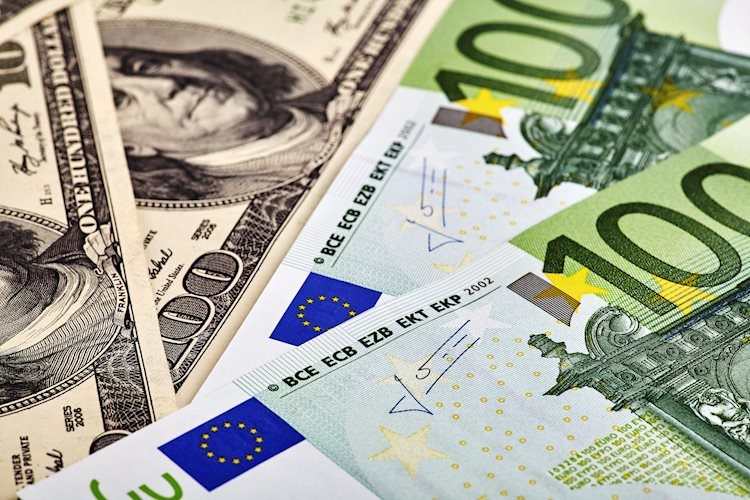- EUR/USD returned to its bearish ways on Friday.
- A broad upswing in the Dollar Index continues to pummel the Euro.
- Coming up next week: DST, EU CPI, US PCEPI, and another NFP print.
EUR/USD trimmed a near-term rebound on Friday, slamming the door on a clean bullish recovery and keeping bids trapped near the 1.0800 handle to round out the trading week. Fiber shed another half of a percent from Monday’s opening bids, challking in a fourth straight losing week and dragging price action down even further from late September’s peak just north of 1.1200.
Markets will kick off next week with the start of Daylight Savings Time across the European continent, shifting market open hours by an hour. The front half of the trading week is a sedate affair, with Euro traders looking ahead to Wednesday’s European growth update. Pan-EU Gross domestic Product (GDP) growth is expected to hold steady in the third quarter, forecast to print in-line with the previous quarter’s 0.2%. Meanwhile, the annualized growth figure is expected to tick upwards from 0.6% to 0.8% YoY.
Next Thursday will round out the Euro’s representation on the economic calendar, with preliminary Harmonized Index of Consumer Prices (HICP) inflation for October. Headline EU HICP inflation is expected to rise to 1.9% YoY compared to the previous period’s 1.7%.
Next week is a big showing for US Dollar traders. US Personal Consumption Expenditure Price Index (PCEPI) figures land on Thursday, followed by another round of monthly US Nonfarm Payrolls (NFP) jobs data on Friday. Core US PCEPI is expected to have ticked higher in September, forecast to print at 0.2% MoM compared to August’s 0.1%. US NFP net jobs additions are expected to cool off to a moderate 140K net new jobs added in October, down from the previous month’s blowout 254K print.
EUR/USD price forecast
The EUR/USD pair is currently trading below the 50-day EMA and 200-day EMA, signaling a bearish sentiment in the market. The recent price action shows a strong downward momentum from early October, where the price broke below the 50-day EMA and continued to dip beneath the 200-day EMA, further confirming the bearish bias. The current price near 1.0795 is testing a support zone, as evidenced by the small-bodied candles, suggesting some consolidation or an indecisive phase. If the support holds, we could see a temporary pullback towards the 1.0899 resistance level, coinciding with the 200-day EMA. However, a failure to break higher could invite further downside pressure.
The MACD histogram shows weakening negative momentum, but the signal lines remain in bearish territory, suggesting that sellers are still in control despite a possible short-term correction. If the price fails to break above the 50-day EMA near 1.0962, the pair could extend its decline. Smart Money Concepts (SMC) traders may note the formation of a liquidity grab below previous lows, potentially indicating institutional accumulation for a pullback. However, unless key resistance zones are reclaimed, the overall structure remains bearish, and a break below 1.0750 could open the door for further losses toward 1.0650.
EUR/USD daily chart
Euro FAQs
The Euro is the currency for the 19 European Union countries that belong to the Eurozone. It is the second most heavily traded currency in the world behind the US Dollar. In 2022, it accounted for 31% of all foreign exchange transactions, with an average daily turnover of over $2.2 trillion a day. EUR/USD is the most heavily traded currency pair in the world, accounting for an estimated 30% off all transactions, followed by EUR/JPY (4%), EUR/GBP (3%) and EUR/AUD (2%).
The European Central Bank (ECB) in Frankfurt, Germany, is the reserve bank for the Eurozone. The ECB sets interest rates and manages monetary policy. The ECB’s primary mandate is to maintain price stability, which means either controlling inflation or stimulating growth. Its primary tool is the raising or lowering of interest rates. Relatively high interest rates – or the expectation of higher rates – will usually benefit the Euro and vice versa. The ECB Governing Council makes monetary policy decisions at meetings held eight times a year. Decisions are made by heads of the Eurozone national banks and six permanent members, including the President of the ECB, Christine Lagarde.
Eurozone inflation data, measured by the Harmonized Index of Consumer Prices (HICP), is an important econometric for the Euro. If inflation rises more than expected, especially if above the ECB’s 2% target, it obliges the ECB to raise interest rates to bring it back under control. Relatively high interest rates compared to its counterparts will usually benefit the Euro, as it makes the region more attractive as a place for global investors to park their money.
Data releases gauge the health of the economy and can impact on the Euro. Indicators such as GDP, Manufacturing and Services PMIs, employment, and consumer sentiment surveys can all influence the direction of the single currency. A strong economy is good for the Euro. Not only does it attract more foreign investment but it may encourage the ECB to put up interest rates, which will directly strengthen the Euro. Otherwise, if economic data is weak, the Euro is likely to fall. Economic data for the four largest economies in the euro area (Germany, France, Italy and Spain) are especially significant, as they account for 75% of the Eurozone’s economy.
Another significant data release for the Euro is the Trade Balance. This indicator measures the difference between what a country earns from its exports and what it spends on imports over a given period. If a country produces highly sought after exports then its currency will gain in value purely from the extra demand created from foreign buyers seeking to purchase these goods. Therefore, a positive net Trade Balance strengthens a currency and vice versa for a negative balance.
Read the full article here

